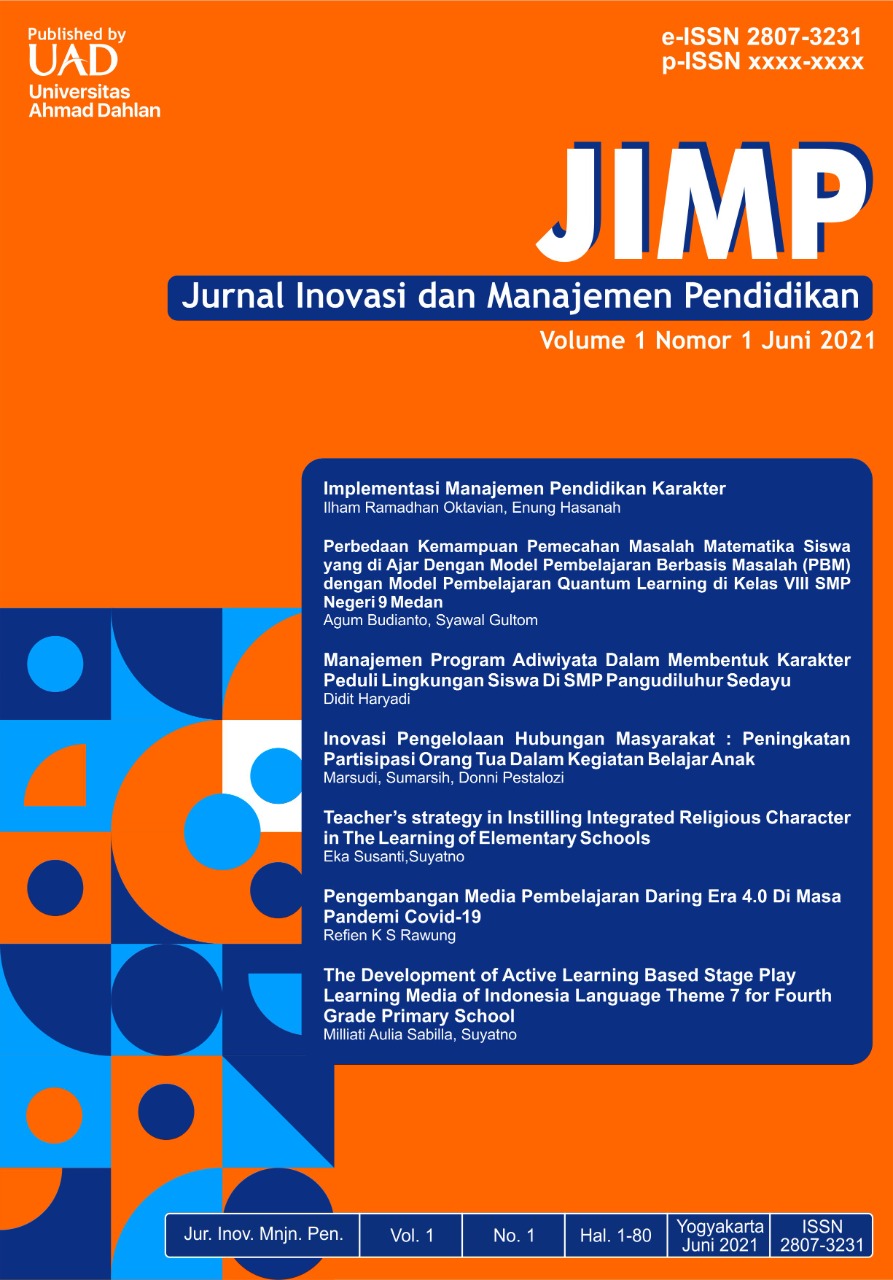Teacher’s strategy in Instilling Integrated Religious Character in The Learning of Elementary Schools
DOI:
https://doi.org/10.12928/jimp.v1i1.4142Keywords:
Teacher’s strategy, Religious Character, Elementary SchoolsAbstract
This study describes the teacher’s strategy to instill integrated religious character in Muhammadiyah elementary school Demangan of Yogyakarta. This qualitative study research with a study case. The research data was collected through observation, interviews, and documentation. In this study, The research subject consisted of the principal, fifth-grade teacher, the students, and student guardians. The data validity test used the triangulation technique and sources. Data analysis techniques included data reduction, data presentation, and conclusion. The research result showed that the teacher’s strategy is to instill integrated religious character in learning by integrating religious character in the entire learning components, religious character internalization, religious character habituation, and religious character role model.
References
Afandi, R. (2011). Integrasi pendidikan karakter dalam pembelajaran IPS di sekolah dasar. PEDAGOGIA: Jurnal Pendidikan, 1(1), 85-98.
Arikunto, S. (2013). Suharsimi. 2010. Prosedur Penelitian Suatu Pendekatan Praktik.
Creswell, J. W., & Poth, C. N. (2016). Qualitative inquiry and research design: Choosing among five approaches. Sage publications.
Emzir. (2014). Metodologi Penelitian Kualitatif Analisis Data. Jakarta: Rajawali Pers.
George, A. L., & Bennett, A. (2005). Case studies and theory development in the social sciences. mit Press.
Gunawan, H. (2012). Pendidikan karakter. Bandung: Alfabeta, 2.
Hikmawati, C. R. (2013). Penerapan Strategi Mind Map Untuk Peningkatan Hasil Belajar Ips Siswa Kelas V Sekolah Dasar. Jurnal Penelitian Pendidikan Guru Sekolah Dasar, 1(2), 1-11.
Hilda. A. (2017). "Pendidikan Karakter dalam Perspektif Pendidikan Islam." Jurnal Pendidikan UNIGA 8, no. 1, 1-26.
Listyarti, R. (2012). Pendidikan Karakter dalam Metode Aktif, Inovatif, dan Kreatif. Jakarta: Erlangga, 4(1).
Lumpkin, A. (2008). Teachers as role models teaching character and moral virtues. Journal of Physical Education, Recreation & Dance, 79(2), 45-50.
Miles, M. B., & Huberman, A. M. (1994). Qualitative data analysis: An expanded sourcebook. sage.
Moleong, L. J. (2006). Metode penelitian kualitatif edisi revisi. Bandung: Remaja Rosdakarya.
Sani, R. A., & Kadri, M. (2016). Pendidikan Karakter: Mengembangkan Karakter Anak yang Islami. Bumi Aksara.
Sultonurohmah, N. (2017). Strategi penanaman nilai karakter jujur dan disiplin siswa. Al-Ibtida, 5(2), 1-21.
Suparyogo, I. (2001). Metode Penelitian Kuantitatif Kualitatif dan R&D. Bandung: Alfabeta.
Suryanti, E. W., & Widayanti, F. D. (2018, October). Penguatan Pendidikan Karakter Berbasis Religius. In Conference on Innovation and Application of Science and Technology (CIASTECH) (Vol. 1, No. 1, pp. 254-262).
Suyatno, Jumintono., Pambudi, D. I., & Mardati, A. Wantini (2019). Strategy of Values Education in the Indonesian Education System. International Journal of Instruction, 12(1), 607-624.
Wibowo, A. (2012). Pendidikan karakter: Strategi membangun karakter bangsa berperadaban. Pustaka Pelajar.
Widodo, H. (2019). Pendidikan Holistik Berbasis Budaya Sekolah. UAD PRESS.
Widodo, H., & Risti P, A. V. (2017). Pendidikan Karakter Holistik Integratif di PAUD Terpadu ‘Aisyiyah Nur’aini Ngampilan Yogyakarta. AL-ATHFAL: JURNAL PENDIDIKAN ANAK, 3(2), 135-150.
Yaumi, M. 2016). Pendidikan karakter: landasan, pilar & implementasi. Prenada Media.
Yin, R. K. (2003). Designing case studies. Qualitative Research Methods, 359-386.
Yin, R. K. (2009). How to do better case studies. The SAGE handbook of applied social research methods, 2, 254-282.
Downloads
Published
How to Cite
Issue
Section
License
Copyright (c) 2021 Univesitas Ahmad Dahlan

This work is licensed under a Creative Commons Attribution-ShareAlike 4.0 International License.
This article's copyright is transferred to Universitas Ahmad Dahlan (UAD) if and when the item is accepted for publication. The undersigned hereby transfers any rights in and to the paper including without limitation all copyrights to UAD. The undersigned hereby represents and warrants that the article is original and that he/she is the author of the paper, except for material identified as to its source, with permission notices from the copyright owners where required. The undersigned represents that he/she has the power and authority to make and execute this assignment.
We declare that:
This paper has not been published in the same form elsewhere.
It will not be submitted anywhere else for publication before acceptance/rejection by this Journal.
Copyright permission is obtained for materials published elsewhere and which require this permission for reproduction.
Furthermore, I/We hereby transfer the unlimited rights of publication of the above-mentioned paper in whole to UAD. The copyright transfer covers the exclusive right to reproduce and distribute the article, including reprints, translations, photographic reproductions, microform, electronic form (offline, online), or any other reproductions of similar nature.
The corresponding author signs for and accepts responsibility for releasing this material on behalf of any co-authors. This agreement is to be signed by at least one of the authors who have obtained the co-author(s) assent where applicable. After submission of this agreement signed by the corresponding author, changes of authorship or in the order of the authors listed will not be accepted.
Retained Rights/Terms and Conditions
Authors retain all proprietary rights in any process, procedure, or article of manufacture described in the Work.
Authors may reproduce or authorize others to reproduce the Work or derivative works for the author's personal use or company use, provided that the source and the UAD copyright notice are indicated, the copies are not used in any way that implies UAD endorsement of a product or service of any employer, and the documents themselves are not offered for sale.
Although authors are permitted to re-use all or portions of the Work in other works, this does not include granting third-party requests for reprinting, republishing, or different types of re-use.







